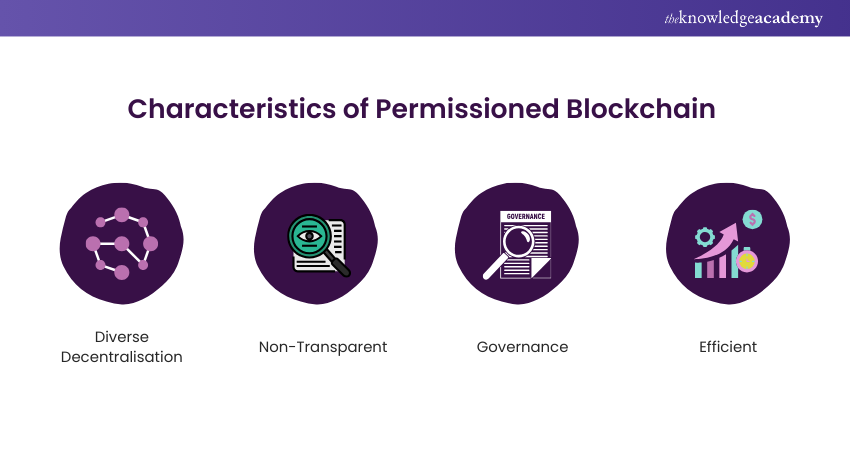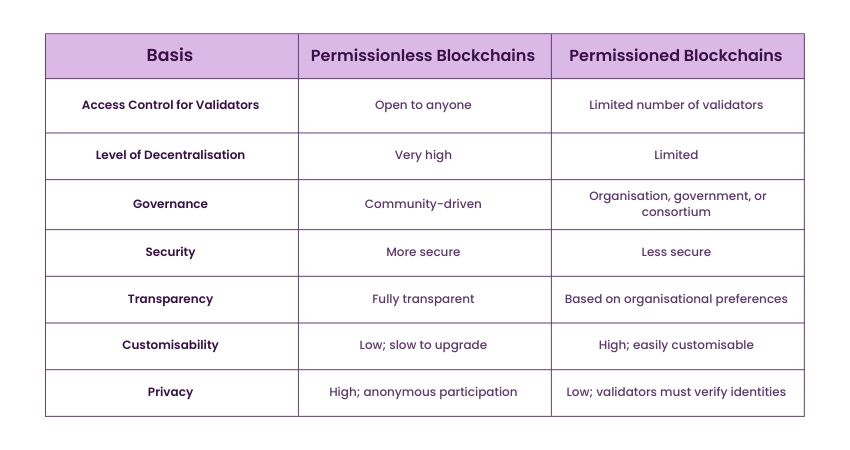We may not have the course you’re looking for. If you enquire or give us a call on +60 1800812339 and speak to our training experts, we may still be able to help with your training requirements.
Training Outcomes Within Your Budget!
We ensure quality, budget-alignment, and timely delivery by our expert instructors.

Blockchain that is closed (i.e., not accessible to the general public) or contain an access control layer are referred to as Permissioned Blockchain. Permissioned Blockchain is a distributed ledger that can only be accessed by users with permissions. Permissioned Blockchains are designed to Benefit From Blockchain Technology without compromising the centralised system's authority.
According to Statista, as of August 2017, the results of a survey asked senior executives in Asia-Pacific about their preferred type of Blockchain to use in their businesses. During the survey period, 45 percent of respondents said they wanted to use a Permissioned Blockchain.
In this blogs, we will learn what Permissioned Blockchain is, how it works, and its benefits and drawbacks. We will review some of the finest Permissioned Blockchains available, the different types of DLTs, and other crucial Permissioned Blockchain topics to get a complete overview.
Table of Contents
1) What is Permissioned Blockchain?
2) Characteristics of Permissioned Blockchain
3) Types of Permissioned Blockchain
4) Advantages of Permissioned Blockchain
5) Disadvantages of Permissioned Blockchain
6) List of best Permissioned Blockchain
7) Difference Between Permissioned and Permissionless Blockchains
8) Where can Permissioned and Permissionless Blockchain be Used?
9) Why are Permissioned Blockchains Ideal for Business Applications?
10) Conclusion
What is Permissioned Blockchain?
Permissioned Blockchains are closed networks featuring an access control layer that restricts participants to specific tasks they are authorised to perform. In such a Blockchain, users need permission from the network owner to join. Once granted access, they can view, read, and write information based on their permissions.
A private Permissioned Blockchain defines roles that dictate how and what each member can contribute. These Blockchains also offer customisation options. For instance, identity verification can be used to allow users to join the network without direct approval from the network owner. Users can then perform activities according to the predefined permissions of the Blockchain.
Often referred to as “Private Blockchains” or “Permissioned sandboxes,” Permissioned Blockchains are considered partially decentralised. Unlike Bitcoin, the network is distributed among known participants.
A notable example of a Permissioned Blockchain is Ripple, a prominent cryptocurrency that assigns permission-based roles to its users. Many organisations favor Permissioned Blockchain networks because they enable administrators to adjust settings and impose necessary limitations.
Characteristics of Permissioned Blockchain

Some of the distinctive characteristics of a Permissioned Blockchain are inextricably linked to security. Since there is an access control layer, Permissioned Blockchains are considered more secure than public Blockchain systems such as Bitcoin.
As a result, it is preferred by those who need to define roles, authenticate identities, and secure access inside a network. Permissioned Blockchains are usually not anonymous and are often produced by private entities such as enterprises and private groups.
Diverse Decentralisation
Permissioned Blockchains can vary in their level of decentralisation. They can be partially or entirely centralised, with the degree of decentralisation and the chosen consensus mechanisms often determined by the members of the Blockchain network.
Non-Transparency
Permissioned Blockchains do not offer transparency. Privacy is maintained through cryptography, which protects the identity and data of individuals or users. Only the central entity knows the identities involved.
Governance
Permissioned Blockchains are governed by the organisation, combining a decentralised nature with central control. In such networks, the organisation can include validators to authenticate transactions.
Efficiency
Permissioned Blockchains are highly efficient due to their speed and scalability. Advanced technology prevents hackers from targeting a single repository, enhancing security.
Preparing for a Job Interview? Check out our Blockchain Interview Questions!
Types of Permissioned Blockchain
Bitcoin's Blockchain technology was simple. It was a public peer-to-peer network that could perform transactions without centralised authority, and each node had its copy of the ledger.
However, it is not the only Blockchain or Distributed Ledger Technology that can be used. DLTs are classified into several types. To get a better picture, let's list them briefly.
Public Permissioned Blockchain
The most common type of Blockchain is a public Blockchain, which allows anyone to join, conduct transactions, and participate in the consensus process. Several well-known public Blockchains exist, such as Bitcoin and Ethereum. Bitcoin, the first-generation cryptocurrency, employs the most fundamental Blockchain concept. Ethereum adds further value by enabling developers to create decentralised apps (dApps) using smart contracts. Public Blockchains use a consensus algorithm that does not require a Permissioned approach. They are open source, and anyone can join the network without prior authorisation.
Private Permissioned Blockchain
Private Blockchains are similar to Permissioned Blockchains but differ in some respects. Private Blockchains are completely closed to the public, whereas Permissioned Blockchains may have certain conditions for public participation. Both are restrictive in nature, but their approaches vary slightly.
Federated Permissioned Blockchain
Federated or Consortium Blockchains fall under the concept of Permissioned Blockchains. External parties are not allowed to participate in these Blockchains. They offer various advantages, including greater scalability, making them an ideal solution for large businesses. Examples of Permissioned Blockchains include R3, B3i, and Hyperledger.
Learn the fundamentals of Blockchain 101 and Ethereum. Sign up for our Ethereum Developer Training now!
Advantages of Permissioned Blockchain
Permissioned Blockchains provide various benefits, which make them preferable to use compared to Permissionless Blockchain. Here are some advantages:
1) Efficient Performance
Permissioned Blockchains outperform permissionless Blockchains in terms of performance. The main reason for this is the platform's limited number of nodes. This eliminates the need for additional computations to obtain network consensus, enhancing overall speed. Furthermore, Permissioned networks have their pre-determined nodes for transaction validation.
2) Governance Framework
Permissioned networks have an adequate governance framework. This indicates that they are well-organised. Administrators also need less time to alter the network's rules, which is significantly faster than with public Blockchains. The public Blockchain network suffers from a consensus problem as not all nodes cooperate in deploying the latest version. These nodes may prioritise their interests over the demands of the Blockchain, resulting in slower network updates. In contrast, Permissioned Blockchain does not have this issue since nodes collaborate to move updates quicker.
3) Cost-effective
Permissioned Blockchains are unquestionably more cost-effective than permissionless Blockchains. As we can see, Permissioned networks are essential to various industries. Permissioned networks provide substantial potential benefits for banking and supply chain industries.
Disadvantages of Permissioned Blockchain
Permissioned Blockchains are not without flaws. Here are some of the drawbacks of Permissioned Blockchains:
1) Compromised Security
A public or private Blockchain provides higher security as nodes correctly engage in a consensus procedure. However, this may not be the case with Permissioned Blockchains. A Permissioned network's security is only as good as its members' integrity. This means that a small section of a Permissioned system can collaborate to alter data stored on the network. To fix it, the system should have correct permissions configured so that the bad actors cannot combine to cause the intended impact.
2) Regulation and Censorship
In an ideal world, these Permissioned Blockchains would function similarly to public Blockchains but with additional regulations. However, the restrictions introduce censorship into the network, as the authority can restrict or prevent a transaction from happening. These pose a risk to any company or organisation that uses the Permissioned network. This strategy also prevents the Permissioned network from fully utilising the Blockchain ecosystem.
3) Lack of Transparency
As it is limited to only some people and is controlled by a private group, there is a high risk of collision and overriding of consensus. As such, the operators of the network can easily alter consensus rules.
List of best Permissioned Blockchains
As you can see, Permissioned networks are crucial to various industries. Permissioned networks can benefit industries such as banking and supply chains.
Corda, Ripple and Hyperledger Fabric are some of the essential Permissioned Blockchains. These are the top Permissioned solutions. Let's take a quick look at each of the Permissioned Blockchains that fall under the category of best-Permissioned Blockchain.
1) Corda
Corda is a Permissioned and highly secure Blockchain framework, making it an excellent choice for developing financial Blockchain Applications. Corda enables CorDapp identities to be solely connected to legal entities by offering a single identity and mutual membership, lowering security threats.
Corda has the extra benefit of making it simple for businesses to execute transactions across numerous networks because it can be linked with any current payment rail.
2) Hyperledger
The Hyperledger platform is an open-source Blockchain technology created by the Hyperledger and Linux foundations.
This framework is based on a consensus technique known as Proof of Elapsed Time (PoET) and Practical Byzantine Fault Tolerance (PBFT).
Hyperledger is the best solution for distributed ledger networks and applications. Developers can define business rules for their Blockchain apps in the language of their choice, which speeds up Blockchain app development.
3) Ripple
Ripple is another Blockchain platform focused on the development of financial software applications. Payment providers, digital asset exchanges, banks, and any other company can be connected to the Blockchain using the Ripple architecture, allowing for the unfettered supply of financial services.
Furthermore, Ripple provides liquidity solutions that relieve enterprises from pre-funding limitations and allow them to construct a decentralised infrastructure to execute payments in under three seconds.
Learn how bitcoins work and how to secure bitcoins. Register for our Bitcoin and Cryptocurrency Course now!
Difference Between Permissioned and Permissionless Blockchains
There are several distinctions between Permissionless and Permissioned Blockchains. The table below provides an overview of Permissioned Blockchain vs Permissionless Blockchain.

Where can Permissioned and Permissionless Blockchain be Used?
Permissioned and Permissionless Blockchains have various architectural styles that can be advantageous for some applications and disadvantageous for others.
For instance, permissionless Blockchain technology can create a strong financial platform built on a decentralised platform. It can be used for file storage for the general public and digital trading, donations, and crowdfunding. Users can readily access it because it has no access restrictions.
In applications like supply chain tracking, claim settlements, and identity verification, Permissioned Blockchain offers the controlled user access to the data. Permissioned Blockchain is the most appropriate technology for these applications because they are built on privacy and have limited access to specific people.
Are you interested in learning how Blockchain can secure your transactions? Sign up for the Blockchain Training Course today!
Why are Permissioned Blockchains ideal for Business Applications?
Due to limits in efficiency and scalability, Permissionless Blockchain systems are currently unable to meet the performance requirements of many enterprise use cases.
The identity of the participants is also a crucial requirement in situations where Permissioned Blockchains are replacing current secure, centralised networks, such as in financial transactions where Know-Your-Customer (KYC), Anti-Money Laundering (AML), and supply-chain provenance regulations must be adhered to.
For business use, it should have the following requirements:
1) Low confirmation delay for transactions
2) Networks must be granted authorisation
Participants must be identifiedData related to commercial transactions should be kept private and secret.
Conclusion
Permissioned Blockchains will be there for a long time. They deliver Blockchain benefits in a closed ecosystem while ensuring that an organisation's needs are met. It has significant advantages, such as cost-effectiveness, competent governance, and efficient performance.
If you are new to the Blockchain industry, you must first learn Blockchain technology's fundamentals. Check out The Knowledge Academy's most popular Blockchain Training Courses on Blockchain Technology.
Frequently Asked Questions

Permissioned Blockchains offer some degree of immutability, but it is not as strong as in permissionless Blockchains. Changes can be made based on the governance rules set by the network’s administrators.

Yes, Ethereum can be permissioned. While the public Ethereum network is permissionless, private or consortium versions of Ethereum can be configured as Permissioned Blockchains, restricting access and control to a specific group.

The Knowledge Academy takes global learning to new heights, offering over 30,000 online courses across 490+ locations in 220 countries. This expansive reach ensures accessibility and convenience for learners worldwide.
Alongside our diverse Online Course Catalogue, encompassing 17 major categories, we go the extra mile by providing a plethora of free educational Online Resources like News updates, Blogs, videos, webinars, and interview questions. Tailoring learning experiences further, professionals can maximise value with customisable Course Bundles of TKA.

The Knowledge Academy’s Knowledge Pass, a prepaid voucher, adds another layer of flexibility, allowing course bookings over a 12-month period. Join us on a journey where education knows no bounds.

The Knowledge Academy offers various Blockchain Training, including Ethereum Developer Training, Blockchain Training and Bitcoin and Cryptocurrency Course. These courses cater to different skill levels, providing comprehensive insights into various Blockchain Developer Skills.
Our Advanced Technology Blogs cover a range of topics related to Blockchain, offering valuable resources, best practices, and industry insights. Whether you are a beginner or looking to advance your Blockchain knowledge, The Knowledge Academy's diverse courses and informative blogs have you covered.
Upcoming Programming & DevOps Resources Batches & Dates
Date
 Blockchain Training Course
Blockchain Training Course
Thu 16th Jan 2025
Thu 6th Mar 2025
Thu 22nd May 2025
Thu 24th Jul 2025
Thu 4th Sep 2025
Thu 20th Nov 2025
Thu 11th Dec 2025







 Top Rated Course
Top Rated Course



 If you wish to make any changes to your course, please
If you wish to make any changes to your course, please


